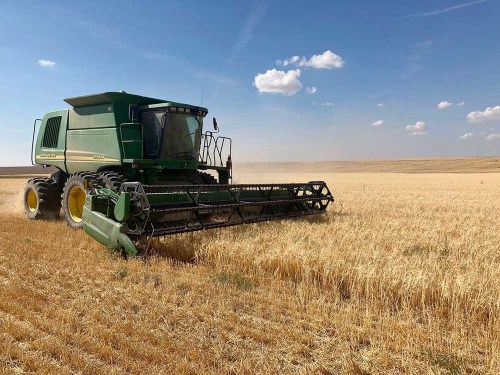Pacific Northwest barley harvest ‘better than expected’
Published 11:30 am Friday, August 18, 2023

- Spencer Miller harvests spring barley the afternoon of Aug. 8, 2023, west of Ritzville, Washington. Across the Pacific Northwest, barley growers are reporting a better crop than expected.
RITZVILLE, Wash. — It’s been two years since Mike Miller grew barley. This year, he wanted to see how it fared on some land west of Ritzville, Washington, that hadn’t had a spring crop in more than a decade.
“It went above my expectations … and the test weight was quite high,” he said. “It was very short, rough to cut, but yes, I’m very pleasantly surprised.”
Trending
That’s the case for barley growers across the Pacific Northwest, reporting a better crop than originally anticipated.
Miller, a Washington Grain Commission board member, raised about 300 acres of spring barley this year, a “minimal” percentage of his overall farming operation, which includes four classes of wheat, alfalfa and potatoes.
Miller primarily uses barley as a rotation crop. Normally, he raises triticale, which usually has fewer inputs and yields better, he said.
Miller said barley prices were hovering around $200 per ton. He would prefer an additional $50 per ton, or more.
“We’ll see if we grow it again next year,” he said. “A lot of it is, the price has got to come up.”
IdahoIdaho’s harvest is probably about half done, said Laura Wilder, executive director of the Idaho Barley Commission.
Trending
“Overall, in Eastern Idaho, Southern Idaho and Northern Idaho, either farmers are finished with barley or in the throes of it right now,” she said.
Many barley farmers started several weeks late due to a cool, wet spring. Some higher-elevation areas had snow and cold weather in June, Wilder said.
Some winter-killed winter barley was replanted to spring barley.
With summer heat, the crop caught up “nicely,” she said.
“With the late crop, everyone was worried about it getting hot too fast and having thins and some quality issues,” Wilder said. “But I’m hearing the quality is excellent to good, and the yields are better than expected.”
One Eastern Idaho barley commissioner reported his best yields yet. A Twin Falls farmer had a spring barley yield of more than 200 bushels per acres.
Idaho’s average last year was 111 bushels per acre.
The 10-year average is slightly over 100 bushels per acre. Irrigated farmers can get 150 to 180 bushels per acre.
About 80% of Idaho’s crop is irrigated.
Most acres are contracted for malt barley, with some food and feed barley.
In 2022, Idaho harvested 540,000 acres of barley. This year, about 590,000 acres were planted.
“Our yields may not be a record, but with our acres up a little, production should be close to what it was last year on total bushels,” she said.
Prices for this year’s crop were mostly contracted last fall, and were “very strong” coming off of the 2021 drought year. Companies were trying to get supplies back up, Wilder said.
Production costs have leveled off or gone down in some areas, but are still “quite high” for fuel, equipment, and supply chain issues still affect parts availability. Fertilizer costs have slightly declined, Wilder said.
“For this year’s crop, the prices are good enough that we should be fine,” she said.
Contracting for the 2024 crop will begin soon. Barley prices typically follow wheat prices, which are also slightly down, Wilder said.
Cash prices range from $8.20 to $9.40 per hundredweight for feed barley, and $8.30 to $15.50 per hundredweight for malt barley.
“It’s been a rollercoaster year for growers around the region, which is not untypical,” Wilder said. “Those types of conditions cause a lot of stress for growers, so I’m really pleased to see the overall crop looking fantastic.”
WashingtonThe barley crop is looking “surprisingly” good, said Mary Palmer Sullivan, vice president of the Washington Grain Commission.
Expectations were for an average crop, but grain elevators receiving barley said proteins were stable, and coming in lower than the contract maximum of 12.5%, she said.
Grain elevators contract with malting companies and seek out farmers to raise the barley, Sullivan said.
“It sounds like the contracts they do have will be able to be fulfilled, which is encouraging,” Sullivan said.
She estimated harvest was about 35% complete.
“Those that got their barley in early were able to capture some of those timely rains,” Sullivan said.
Prices are slightly down from the previous year, Sullivan said, and cost of production is up for any farmer, she said.
Sullivan usually asks farmers if they planted barley.
“Jokingly, the response I get back: ‘No, I want to make money,’” she said. “If barley was more profitable, we’d have a lot more grown.”









